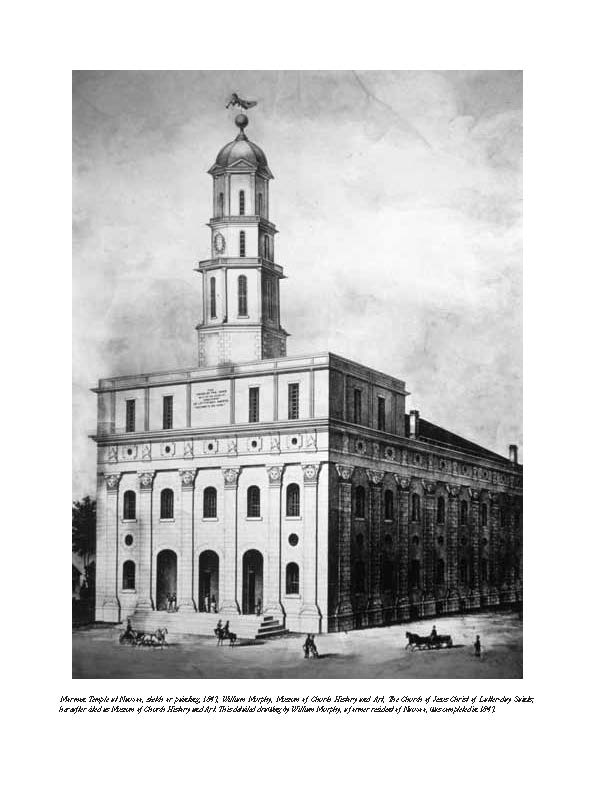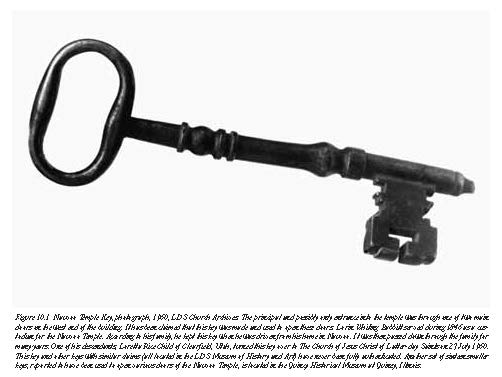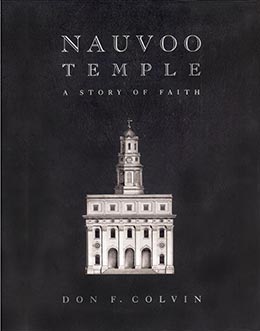The Dedication of the Temple
Don F. Colvin, “The Dedication of the Temple,” in Nauvoo Temple: A Story of Faith (Provo, UT: Religious Studies Center, 2002), 245–51.
 As each section of the building was completed, it became the practice of Church leaders to dedicate that portion of the temple to God and then to press it into service. Such a procedure was justified under the peculiar circumstances of the time. The Saints in Nauvoo felt a great need for the facilities offered by the temple. No chapels existed in Nauvoo for worship services, and office space for administrative needs was either limited or nonexistent. The Saints were also anxious to perform their temple ordinance work at the earliest opportunity. Added to these conditions was the relentless and ever-growing pressure by enemies to drive the Latter-day Saints out of Illinois. Had they waited until the building was completed before dedicating and using any portion, it is very doubtful that the structure would have ever served its builders.
As each section of the building was completed, it became the practice of Church leaders to dedicate that portion of the temple to God and then to press it into service. Such a procedure was justified under the peculiar circumstances of the time. The Saints in Nauvoo felt a great need for the facilities offered by the temple. No chapels existed in Nauvoo for worship services, and office space for administrative needs was either limited or nonexistent. The Saints were also anxious to perform their temple ordinance work at the earliest opportunity. Added to these conditions was the relentless and ever-growing pressure by enemies to drive the Latter-day Saints out of Illinois. Had they waited until the building was completed before dedicating and using any portion, it is very doubtful that the structure would have ever served its builders.
The Dedication of Separate Sections
The Wooden Baptismal Font
Pushed to completion during the first year of construction, the temporary wooden baptismal font was the first portion of the building to be used. Brigham Young dedicated it in appropriate ceremonies at 5 p.m. on 8 November 1841. [1]
The Enclosed Building
On 5 October 1845 the first and only official general conference of the Church ever held in the enclosed building took place. By this time the building was nearing completion with all the outside work finished. President Brigham Young “opened the services of the day by a dedicatory prayer, presenting the Temple, thus far completed, as a monument of the saints’ liberality, fidelity, and faith, concluding: "Lord, we dedicate this house and ourselves, to thee.’" [2] Following this dedication, Sunday worship services, prayer meetings, and administrative meetings were conducted regularly in the temple.
The Attic Story
On Sunday, 30 November 1845, the newly completed attic story was dedicated. The meeting was called to order at noon, and William Clayton was requested to keep minutes of the proceedings. After an opening song Brigham Young offered the prayer of dedication. He prayed that God would sustain and deliver his servants from their enemies until they could accomplish his will in the temple. Additional prayers and songs were also part of the meeting. [3] This portion of the building was then used for council meetings, quorum leadership meetings, and more importantly for endowment ordinances, eternal marriages, and sealings.
A Sealing Altar
A new altar, located in the southeast corner room of the main attic, was dedicated on 7 January 1846. It was used for the sealing of marriages and family groups. The dedication took place in the afternoon, attended by the Twelve, the Presiding Bishops, and their wives. [4]
Dedication Prior to Exodus
On the occasion of the exodus from Nauvoo, another dedication of the then uncompleted structure took place, recorded by Brigham Young: “I met with the Council of the Twelve in the southeast corner room of the attic of the Temple. We knelt around the altar, and dedicated the building to the Most High. We asked his blessing upon our intended move to the west; also asked him to enable us someday to finish the Temple, and dedicate it to him, and we would leave it in his hands to do as he pleased; and to preserve the building as a monument to Joseph Smith. We asked the Lord to accept the labors of his servants in this land. We then left the temple." [5]
The Formal Dedication of the Entire Building
The final formal dedication of the temple took place after most members of the Church had left the city. Under the direction of Truman Angell, a special crew of workmen remained behind to complete the first story and some other parts of the structure. Orson Hyde, a member of the Quorum of the Twelve Apostles, was assigned to stay in Nauvoo to represent Church leaders. He was to oversee the successful conclusion of the project and dedicate the edifice if the Twelve were unable to return. [6] It had been hoped that the dedication could take place on 6 April, the sixteenth anniversary of the Church's origin. Though work continued at a steady pace, the building simply could not be completed by that date, so Elder Hyde reported to Brigham Young: "The Temple will not be finished to dedicate on the sixth of April. [7] A new date was set for the completion, and the committee issued an announcement of the intended dedication. This announcement, published in three successive issues of the Hancock Eagle (10, 17, and 24 April 1846), reads as follows:
Dedication of the Temple of God in the city of Nauvoo
 This splendid edifice is now completed, and will be dedicated to the Most High God on Friday, the 1st. day of May, 1846. The services of the dedication will continue for three days in succession, commencing on each day at 11:00 o'clock a.m. Tickets may be had at the watch house near the door of the Temple, and also at the office of the Trustees in Trust at $1.00 each.
This splendid edifice is now completed, and will be dedicated to the Most High God on Friday, the 1st. day of May, 1846. The services of the dedication will continue for three days in succession, commencing on each day at 11:00 o'clock a.m. Tickets may be had at the watch house near the door of the Temple, and also at the office of the Trustees in Trust at $1.00 each.
One object of the above is, to raise funds to enable the workmen who have built the Temple to remove to the west with their families, and all who are disposed to see the Mormon's remove in peace and in quietness so soon as circumstances will allow, and [which is the earnest wish of every Latter day Saint] are respectfully invited to attend. We expect some able speakers from abroad to favor us.
Done by order of the Trustees in Trust.
James Whitehead, clerk [8]
As the long-awaited day approached, the temple was a scene of feverish activity. Information on the preparations and an eyewitness account of the private dedication of 30 April 1846 were furnished by Samuel W. Richards:
Thursday 30th spent most of the day at the temple, sweeping out the rooms and making preparation for the Dedication of the House, which had been published to take place on the 1st, 2nd, 3rd days of May. The 1st day being set apart for those who would pay one dollar for admitance which Money should go on payment to the T. hands This day finished my work on the temple and took a cirtificate of the same. . . . Met at sundown in the temple for prayers as usual, after which (with our clothing) we repaired to the lower room for the purpose of Dedicating the same. 30 men selected for that purpose were present. Orson Hyde, W. Woodruff, Joseph Young, & W. W. Phelps were in the company. After some conversation and singing a prayer circle was formed immediately in front of the Melchisedeck stand, O. Hyde was President, and Joseph Young, Mouth after which those present were seated in the stands to represent the order of the priest hood, myself being seated in the Teachers stand, and a Dedication prayer was offered by O. Hyde, to which all responded "amen." after the prayer was ended all shouted with loud voices: "Hosanna, Hosanna, Hosanna to God and the Lamb, Amen Amen, and Amen," which was three times repeated. [9]
This official dedication was held privately as a sacred and reverent occasion by selected Church leaders. It may also have been private because of fear that the public dedication might be disturbed by enemies of the Church. Wilford Woodruff recorded his impressions of this important occasion:
At the edge of the evening I repaired to the Temple And dressed in our Priestly robes in company with Elder Orson Hyde And about 20 others of the Elders of Israel. We dedicated the Temple of the Lord built by the Church of Jesus Christ of Latter Day Saints, unto His Most Holy name. We had An interesting time. Notwithstanding the many false Prophesies . . . that the roof should not go on nor the House be finished And the threats of the mob that we should not dedicate it yet we have done both.
At the Close of the dedication we raised our voices in the united Shout of Hosanna to God And the Lamb which entered the Heavens to the joy And consolation of our hearts. We prayed for the Camp of Israel, for good weather, that we might not be disturbed by any mob untill the dedication was over. I returned home thankful for the privilege of Assisting in the dedication of the Temple of Lord. [10]
President Brigham Young, though not present in person, made this observation: “Elder Joseph Young offered up the dedicatory prayer, dedicating the Temple and all that pertained thereto to the Lord, as an offering to Him as an evidence of the willingness of his people to fulfill his commandments and build His holy house, even at the risk of their lives, and the sacrifice of all their labor and earthly goods. He prayed for the Twelve and all the authorities of the church, for the workmen that had wrought upon the Temple in the midst of persecution, want and suffering, and for the deliverance of the poor; that the Lord would direct the brethren of the camp of Israel, open the way before them and lead them to a place of his own appointment for the gathering of all the Saints." [11]
Following the dedicatory prayers, Elder Hyde made some remarks. After the services were concluded, the entire party assembled in the attic story at the invitation of Elder Hyde and partook of some refreshments. The public dedication began in the morning on the following day, 1 May 1846. Samuel W. Richards recorded an interesting account of this event: “Friday, May 1st. The Temple was dedicated in the presence of strangers and all who would pay one dollar for admittance, attended with my wife. I was one of three who was appointed to seat the congregation, in the house, and stood part of the time at the door to receive tickets. The cervises closed between one and two." [12]
The prayer of dedication was offered by Elder Hyde, who presided over the meeting.
Holy and Everlasting Father, before Thee this morning we present ourselves and acknowledge Thy mercy that has been extended to us since we have been on Thy footstool, and for this opportunity of dedicating this house. . . . We thank Thee that Thou hast given us strength to accomplish the charges delivered by Thee. Thou hast seen our labors and exertions to accomplish this purpose. By the authority of the Holy Priesthood now we offer this building as a sanctuary to Thy Worthy Name. We ask Thee to take the guardianship into Thy hands and grant that Thy Spirit shall dwell here and may all feel a sacred influence on their hearts that His Hand has helped this work. Accept of our offering this morning. . . . Let Thy Spirit rest upon those who have contributed to the building of this temple, the laborers on it that they may come forth to receive kingdoms and dominions and glory and immortal power. Accept of us we pray Thee, inspire every bosom to do Thy will, cause that truth may lead them for the glorious coming of the Son of God when you come in the name of the King, the Lord of Hosts shall be the King. Gather us in Thy kingdom through Jesus Christ, our Lord, Amen. [13]
No report is available on the number of people attending the dedication services of 1 May or 2 May, but it is quite likely that many were in attendance. On the final day of dedication, meetings were mainly attended by Latter-day Saints. During the services a resolution was passed that called for the sale of the temple, with the funds to be used for removing the poor to the main body of the Saints in the West. The resolution was adopted by a unanimous vote. [14] With the temple dedicated, the remaining Church members were now free to join their companions in the trek westward. Less than five months after the temple's dedication, its builders had departed Nauvoo, leaving their beloved building behind as a symbol of their faith and sacrifice.
Notes
[1] Joseph Smith, History of the Church of Jesus Christ of Latter-day Saints, ed. B. H. Roberts, 2d ed., rev. (Salt Lake City: Deseret Book, 1957), 4:446.
[2] B. H. Roberts, ed., History of the Church of Jesus Christ of Latter-day Saints, Period 2: Apostolic Interregnum (Salt Lake City: Deseret Book, 1957), 7:456–57.
[3] Roberts, History of the Church, 7:534–35.
[4] Ibid., 566.
[5] Ibid., 580.
[6] Journal History, 9 March 1846, LDS Church Archives.
[7] Ibid., 27 March 1846.
[8] Hancock Eagle, 10 April 1846.
[9] Diary of Samuel Whitney Richards, 1824–1919, 18, Harold B. Lee Library, Brigham Young University.
[10] Wilford Woodruff, Wilford Woodruff_s Journal, ed. Scott G. Kenney (Midvale, Utah: Signature Books, 1983), 3:41–42.
[11] Brigham Young, Manuscript History of Brigham Young, ed. Elden J. Watson (Salt Lake City: E. J. Watson, 1971), 1 May 1846.
[12] Diary of Samuel Whitney Richards, 19.
[13] David R. Crockett, Saints in Exile (Tucson: LDS Gems, 1996), 295; Deseret News 1999–2000 Church Almanac (Salt Lake City: Deseret News, 1998), 463.
[14] Hancock Eagle, 8 May 1846.
